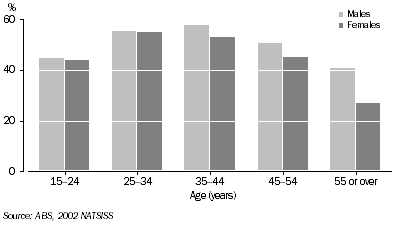Smoking tobacco increases the risk of coronary heart disease, stroke, peripheral vascular disease, numerous cancers and a variety of other diseases and conditions. As a single risk factor, it causes the greatest burden of disease for the total Australian population, accounting for 12% of the burden of injury and disease in males and 7% in females (Mathers, Vos & Stevenson 1999). As chapters 7 and 9 show, Aboriginal and Torres Strait Islander people are at greater risk than non-Indigenous Australians of hospitalisation and/or death from these conditions.
In 2002, just over half (51%) of the Indigenous population aged 15 years or over were cigarette smokers (49% current daily smokers and 2% occasional smokers), consistent with the rate reported in 1994 (52%). Similar proportions of men (51%) and women (47%) were current daily (or regular) smokers, and the highest rates were reported by those aged 25-44 years (graph 8.2). While there was little difference between the overall proportions of Indigenous people in remote and non-remote areas who smoked, males in remote areas were more likely than males in non-remote areas to smoke on a daily basis (56% compared with 48%).
8.2 Current daily smokers, Indigenous persons aged 15 years or over - 2002

Smoking was associated with poorer health outcomes among Aboriginal and Torres Strait Islander people in 2002. For example, regular smokers were more likely than those who did not smoke to report being in fair or poor health (26% compared with 21%) and were less likely to report being in excellent or very good health (40% compared with 48%). Current daily smokers were also more likely than non-smokers to have a disability or long-term health condition (39% compared with 34%).
Indigenous smokers also reported higher rates of other substance use. In 2002, those who regularly smoked were more than twice as likely as those who did not smoke to usually consume risky or high risk amounts of alcohol (21% compared with 10%) (see the Glossary for further details on alcohol consumption risk levels). Moreover, regular smokers in non-remote areas were two and a half times as likely as non-smokers to have recently used illicit substances (34% compared with 14%). This was particularly the case for marijuana use, where 29% of regular smokers had used marijuana in the last 12 months, compared with 9% of non-smokers.
Results from the 2001 NHS indicate that smoking is more prevalent among Indigenous Australians than non-Indigenous Australians. After adjusting for age differences, Indigenous people aged 18 years or over were twice as likely as non-Indigenous people to be current smokers.
 Print Page
Print Page
 Print All
Print All